Annual State of NHSScotland Assets and Facilities Report for 2014
Report on the State of the Estate 2014
2.0 NHSScotland's assets
This section provides information on the current status of NHSScotland's asset and, whilst it provides some comparative information on annual changes, more detailed information on performance trends is described in Section 5.
The responsibility for the management of NHSScotland's assets rests with 14 NHS Boards and 8 Special NHS Boards.
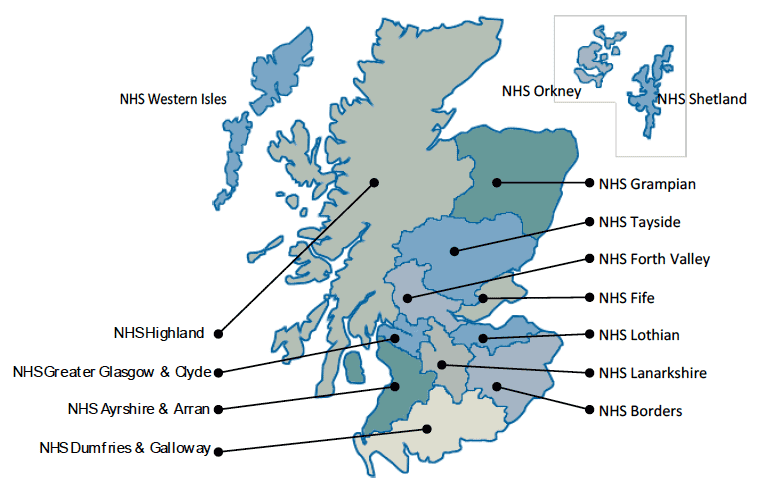
| Special NHS Boards | |
|---|---|
| NHS Education for Scotland | NHS Health Scotland |
| NHS National Services Scotland[1] | NHS National Waiting Times Centre |
| Healthcare Improvement Scotland | NHS 24 |
| Scottish Ambulance Service | The State Hospitals Board for Scotland |
It should be noted that all information presented in this section is broadly based on March 2014 information, unless otherwise stated.
NHSScotland owns physical assets that are worth circa £5.4 billion. Most of these assets relate to the estate (land and buildings) which are estimated to be worth circa £5 billion. Other significant fixed assets which are owned are vehicles, medical equipment and information management and technology (IM&T). An estimate of the Net Book Value of these owned assets is shown in the chart below.
2014 Analysis of NHSScotland Assets by Net Book Value (Total £5,4 billion)
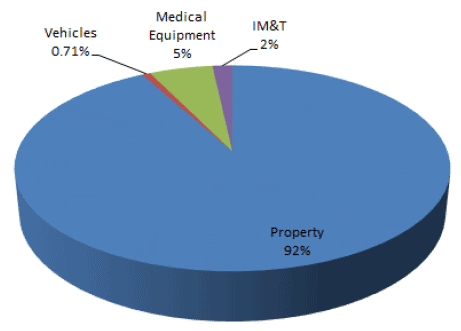
Taken from information returned by each NHS Board
The NHS also has assets which it does not own including buildings, vehicles, medical equipment and IM&T. These assets are estimated to be worth a further £1.5 billion, the majority of which are hospitals and health centres managed under Public Private Partnership (PPP) agreements. Also, the majority of cars used by NHSScotland staff are leased, with staff paying for their own non-business element of these leased vehicles.
In addition to the NHSScotland owned and leased property assets, there are numerous smaller properties used to provide a range of community and family health services provided by GPs, Pharmacists, Dentists and Opticians, many of which are owned or leased by these independent practitioners themselves and paid for indirectly by the NHS through a range of charging and re-imbursement mechanisms.
2.1 Estate Assets
The NHSScotland estate comprises circa 4.5 million sq.m of building floor area encompassing buildings ranging in size from 40 sq.m to 200,000sq.m. The majority (74%) of this is the hospital estate of the 14 NHS Boards and 2 Special NHS Boards (NHS National Waiting Times Centre and the State Hospitals Board). The 2013 ISD Cost Book records this hospital estate as 228 hospitals with a total building area of 3.34 million sq.m. This is broadly similar to that reported in last year's SAFR.
The other property types that account for the further 1.2 million sq. m. include health centres & clinics, day centres, offices, residential accommodation and industrial / storage units.
The tables that follow show an analysis of the hospital estate by type of hospital in terms number of sites and building area.
| Acute | Long Stay | Mental Health | Psychiatric & Learning Disabilities | Community | Other | Total | |
|---|---|---|---|---|---|---|---|
| Number of Hospitals | 38 | 48 | 37 | 14 | 62 | 29 | 228 |
| Area sq.m | 2,147,589 | 254,172 | 428,568 | 46,805 | 200,362 | 259,635 | 3,337,133 |
| Percentage of total area | 64% | 8% | 13% | 1% | 6% | 8% | 100% |
The above table shows that whilst community hospitals are the most numerous (62) they only represent 6% of the total hospital estate in terms of building area i.e. a large number of small hospitals. In contrast, the 38 acute hospitals account for 64% of the total hospital estate in terms of building area.
The number of Long Stay Hospitals has reduced by seven since last year with the following either closed or now used for other purposes:
- Crumhaugh House
- Roadmeetings, Carluke
- Edenhall, Musselburgh
- Royal Victoria, Edinburgh
- Ashludie, Monifieth
- Falkirk Community Hospital
- Montfield, Lerwick
It should also be recognised that a number of the hospitals included in the broad categorisation of "Long Stay Hospitals" includes hospitals with acute long stay beds, psychiatric long stay beds and psychiatric day hospitals. These hospitals may also have other types of beds which are not classified as "long stay".
Providing services more locally is an integral part of the 2020 Vision and this is expected to have an impact on the size and distribution of the hospital estate. Subsequent changes in the hospital estate will continue to be monitored as part of SAFR in future years.
The current distribution of the hospital estate (by numbers of hospitals and by area sq.m) across the Boards is shown in the tables that follow.
| Distribution of hospitals (numbers) across the NHS Boards | |||||||
|---|---|---|---|---|---|---|---|
| Board | Acute | Long Stay | Mental Health | Psychiatric & LD | Community | Other | Total |
| NHS Greater Glasgow | 8 | 6 | 8 | 2 | 0 | 5 | 29 |
| NHS Tayside | 3 | 2 | 5 | 3 | 8 | 7 | 28 |
| NHS Grampian | 4 | 1 | 3 | 1 | 17 | 2 | 28 |
| NHS Highland | 4 | 4 | 2 | 0 | 13 | 4 | 27 |
| NHS Lothian | 4 | 11 | 2 | 2 | 2 | 4 | 25 |
| NHS Dumfries & Galloway | 2 | 5 | 3 | 2 | 4 | 2 | 18 |
| NHS Borders | 1 | 6 | 2 | 0 | 4 | 3 | 16 |
| NHS Lanarkshire | 3 | 5 | 2 | 1 | 4 | 0 | 15 |
| NHS Fife | 2 | 1 | 4 | 1 | 4 | 0 | 12 |
| NHS Forth Valley | 1 | 4 | 4 | 1 | 2 | 0 | 12 |
| NHS Ayrshire & Arran | 3 | 3 | 1 | 1 | 3 | 0 | 11 |
| NHS Western Isles | 1 | 0 | 0 | 0 | 1 | 1 | 3 |
| State Hospital | 0 | 0 | 1 | 0 | 0 | 0 | 1 |
| Golden Jubilee | 0 | 0 | 0 | 0 | 0 | 1 | 1 |
| NHS Orkney | 1 | 0 | 0 | 0 | 0 | 0 | 1 |
| NHS Shetland | 1 | 0 | 0 | 0 | 0 | 0 | 1 |
| 228 | |||||||
| Distribution of hospital estate by area (sq.m) | ||
|---|---|---|
| Board | Total area sq.m | Percentage of NHSScotland Total Area |
| NHS Greater Glasgow | 909,465 | 27% |
| NHS Lothian | 513,418 | 15% |
| NHS Tayside | 409,935 | 12% |
| NHS Grampian | 295,638 | 9% |
| NHS Fife | 255,333 | 8% |
| NHS Ayrshire & Arran | 208,796 | 6% |
| NHS Lanarkshire | 193,996 | 6% |
| NHS Highland | 159,849 | 5% |
| NHS Forth Valley | 147,085 | 4% |
| NHS Dumfries & Galloway | 74,702 | 2% |
| NHS Borders | 62,372 | 2% |
| Golden Jubilee | 47,593 | 1% |
| State Hospital | 23,364 | 1% |
| NHS Western Isles | 20,495 | 1% |
| NHS Shetland | 7,869 | 0.2% |
| NHS Orkney | 7,223 | 0.2% |
| 3,337,133 | 100% | |
2.1.1 Estate Tenure
The majority of the NHSScotland estate is owned but PPP/PFI and leased properties are also significant as shown in the chart that follows.
Estate Tenure
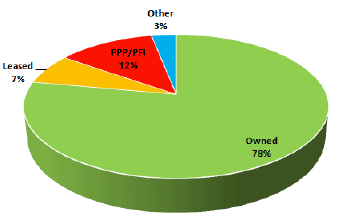
The majority of all office accommodation occupied by the Special NHS Boards is leased.
2.1.2 Estate Age Profile
The chart below shows the age profile of the NHSScotland estate. It shows a reasonable distribution of age profile across this estate, whilst also acknowledging that even with the substantial capital investment over recent years, 25% of the estate remains over 50 years old (note that some older properties are refurbished to modern standards rather than replaced). This age profile has improved from that reported in the 2013 SAFR report, with the percentage of properties less than 50 years old increasing from 72% to 75%.
Estate Age Profile
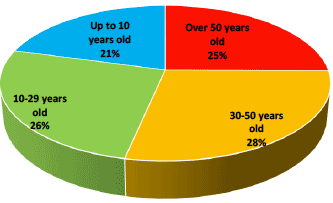
2.1.3 Estate Condition
The Board's report that 59% of their estate is in good physical condition (category A or B) with 37% requiring investment to improve its condition (category C) and 4% being unsatisfactory and requiring major investment or replacement (category D).
2014 Estate Physical Condition Profile
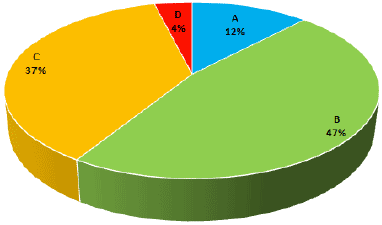
The proportion of the estate in good physical condition of 59% is lower than the 67% reported in the 2013 SAFR. Boards advise that this is as a result of:
- Re-assessment of building condition as a result of the re-surveying of the estate. Typically, this annual resurveying relates to circa 20% of the estate but this year over 35% (1.6m sq.m.) has been re-surveyed. In particular, NHS Greater Glasgow and Clyde, who have the largest estate, has undertaken re-surveying and re-assessment of building condition on circa 40% of its estate. This has had a significant impact on the overall national position shown in the above pie chart.
- The continued lifecycle deterioration of buildings with increased age. The backlog reported annually is that which is currently identified and is a "snapshot" at the particular time and as buildings age, new backlog is identified. This is not always a gradual process and step changes in the identified backlog can occur in particular years particularly in relation to elements of the building with relatively short lifecycles such as some engineering systems.
Without the re-assessment of building condition and identification of new backlog as described above, it is likely that a small improvement (1%) in overall good physical condition would have been reported.
NHS Boards which have buildings assessed as category D - "unsatisfactory" have indicated that they have plans in place to either dispose of or replace these buildings over the next 10 years.
2.1.4 Estate Utilisation
The majority (77%) of the estate is fully utilised although some under utilisation and some overcrowding is evident as shown in the chart below.
Estate Utilisation Chart
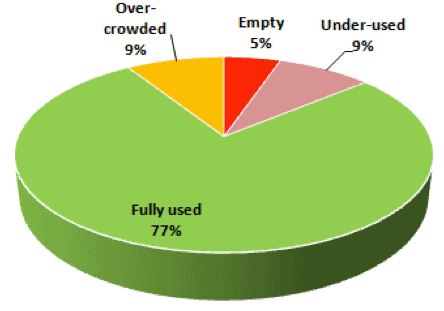
This profile has remained relatively constant.
2.1.5 Estate Functional Suitability
The majority of the estate (65%) is functionally suitable for its current use (categories A and B) but 30% (category C) requires investment to improve its functional suitability and 5% (category D) requires major investment or replacement to achieve satisfactory functionality.
This profile shows a small (3%) decrease in the area of the estate in categories A & B compared to that reported in 2013. Boards have advised that this is as a result of the annual re-assessment of buildings for functional suitability.
2014 Estate Functional Suitability Profile
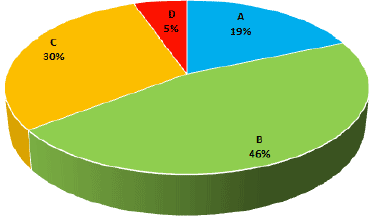
2.1.6 Estate Backlog
NHSScotland's currently identified estate backlog maintenance expenditure requirement is the base cost required to bring those parts of the existing estate which are currently not in satisfactory condition, back to Condition B (satisfactory). It is an on-going challenge for the NHS to balance investment between that which is focussed on service improvement and development, and that which is necessary to maintain buildings in a good condition and ensure that they are safe, reliable and fit for purpose.
An analysis of the backlog expenditure requirement reported by NHS Boards is shown in the chart that follows and identifies a base backlog maintenance expenditure requirement of £797 million, which is a reduction of £61million since 2013. This total also includes £95m of newly identified backlog in 2014 as a result of resurvey work undertaken up to 2014. On a comparative basis, the 2013 figure of £858m included a total of £55m of newly identified backlog up to 2013.
Backlog Maintenance Comparison - NHSScotland Total is £797m
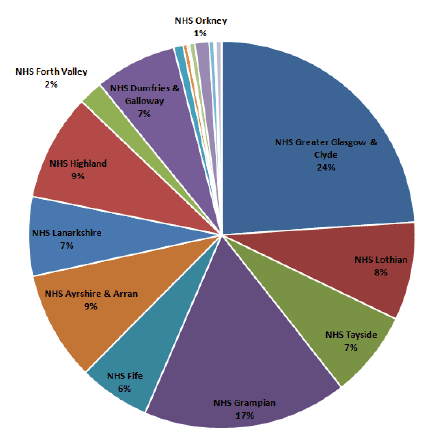
Note: the above chart includes all 22 NHS Boards and Special NHS Boards but those whose backlog is below 1% have not been separately identified for clarity of presentation reasons only.
Whilst there has been a reduction in the overall NHSScotland backlog maintenance expenditure requirement over the last year some NHS Boards have reported an increase in their backlog maintenance expenditure requirement due to reasons of an aging estate and reappraisal/re-surveying of parts of the estate.
The currently identified backlog expenditure requirement reported annually in this report since 2011 has been set at a consistent 2010 price base. However, as the economy continues to recover there are growing pressures to uplift the backlog expenditure requirement to reflect any inflationary rise in the cost of building and engineering works. It is, therefore, planned to update the backlog expenditure costs to take account of inflation in the 2015 SAFR, whilst also tracking underlying trends back to 2010/11 on a consistent base.
The total backlog in the estate has been risk assessed and the results of this are shown in the chart that follows.
Backlog Maintenance Risk Profile
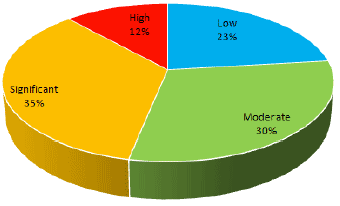
This is a similar risk profile to that reported last year. A significant amount of this backlog cost is in buildings which NHS Boards are planning to dispose of in the next ten years and non-clinical parts of the estate.
Although backlog is identified as expenditure requirement, in practice it is likely to be addressed by a combination of:
- Estate rationalisation and disposal of older properties avoiding the need for expenditure on backlog. Of the total backlog, £80m relates to properties expected to be disposed of in the next 5+ years.
- Replacing older properties with new facilities and avoiding the need for expenditure on backlog e.g. the new South Glasgow Hospitals project, Balfour Hospital in Orkney, and Dumfries and Galloway Royal Infirmary. Of the total backlog, £65m relates to properties expected to be replaced in the next 5+ years.
- Incorporating backlog works within major redevelopment, modernisation and refurbishment projects e.g. improvements to inpatient accommodation at Aberdeen Royal Hospital, Royal Edinburgh Hospital, and Ayrshire Central Hospital. Major refurbishment programmes will remove circa £50m of backlog over the next 5+ years.
- Undertaking specific projects to target the high and significant backlog e.g. inpatient accommodation at Monklands Hospital. Targeted backlog programmes will aim to remove circa £80m of backlog over the next 5+ years.
- Incorporating backlog work within operational repair and cyclical maintenance.
Therefore, whilst the base backlog expenditure requirement is useful for monitoring "year on year" change in backlog it does not necessarily represent further cash requirements in terms of capital or revenue since it is being addressed through the different approaches shown above. Further details on this are provided in section 5.1.4.
Annex B of this report provides further information on the detailed analysis of estate condition and performance (including backlog) which has been undertaken to provide the information in this section of the report.
2.2 Office Accommodation
Data collected in March 2014 through the Smarter Offices Programme identified 223,499 sq.m of dedicated office accommodation across the NHS Boards and Special Boards. This represents circa 5% of the area of NHSScotland's total property assets and play a vital supporting role towards the effective and efficient delivery of healthcare services. This excludes the office accommodation which is embedded within clinical and other accommodation, which would add further to the overall size of the office estate.
Office accommodation for NHS Boards accounts for 165,000 sq.m (4%) of their estate, whereas for Special Health Boards it accounts for 58,000 sq.m (39%) of their estate. NHS Boards own circa 90% of their office accommodation, whereas Special Health Boards lease circa 80% of their office space.
NHS Boards' office accommodation generally has a much older age profile than that of Special Health Boards. This may reflect the fairly common practice in NHS Boards of adapting older and unsuitable clinical accommodation into office accommodation. The impact of this older asset base in NHS Board office accommodation is also reflected in other performance criteria such as poorer physical condition and functional suitability.
The table below summarises the returns received from Boards in March 2014 for the Smarter Offices Programme and shows that the office estate comprises 116 offices housing a staff of 13,868 FTE (15,196 headcount), occupying 14,563 desks at an annual cost of £36.9m.
| Health Boards | Special Health Boards | All Boards | |
|---|---|---|---|
| No of office premises | 72 | 44 | 116 |
| FTE in offices | 9,126 | 4,742 | 13,868 |
| Headcount in Offices | 9,478 | 5,718 | 15,196 |
| No of Desks | 9,497 | 5,066 | 14,563 |
| Total Occupancy Cost £pa | £17,568,982 | £19,314,886 | £36,883,868 |
It should be recognised that over recent years there has been significant rationalisation of office accommodation, particularly for Special Health Boards, with annually submitted PAMS highlighting significant progress in implementing new ways of working, improving utilisation and consolidation of office accommodation across Scotland. The NSS Best Practice Case Study "Office Consolidation and Rationalisation Programme" shown later in this report provides a good example of this progress.
2.3 Vehicle Assets
Analysis of vehicle assets is based on annual pro-forma information returned by each NHS Board. NHSScotland's vehicle assets comprise of approximately 10,400 vehicles, the majority of which are staff car scheme vehicles (59%) and operational cars (15%). The chart below provides a breakdown of NHSScotland's vehicle assets by type.
2014 Analysis of Vehicle assets by type (10,442 total vehicles)
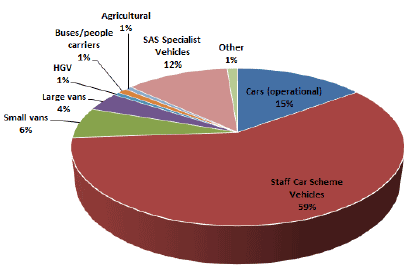
This excludes national logistics vehicles
The distribution of these vehicle assets and their ownership arrangements across NHS Boards and Special Health Boards is shown in the following two charts.
2014 Distribution of vehicles and ownership arrangements across NHS Boards

2014 Distribution of vehicles and ownership arrangements across Special Health Boards
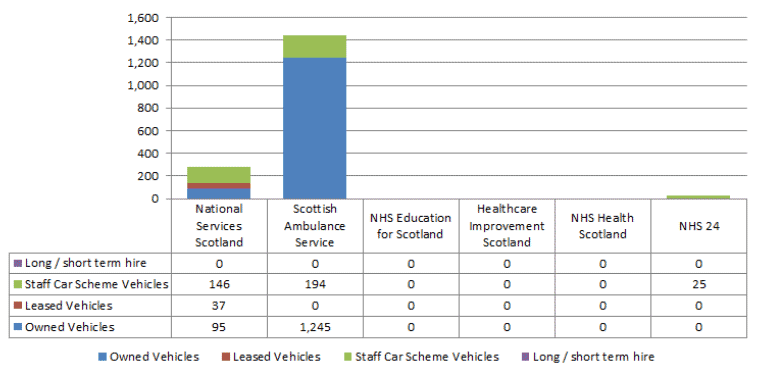
The vehicle age profile and condition profile for all NHS Boards is shown in the charts that follow and shows that circa 49% of the vehicles are less than two years, but with 13% over 5 years old. This represents a reasonable age profile for this asset group and indicates that investment is currently maintaining a reasonable standard of vehicle asset provision. This is also reflected in the overall good / adequate condition of these vehicles, with only 4% considered to be in poor condition.
2014 Vehicle Age Profile
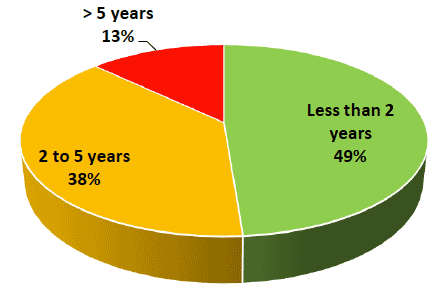
2014 Vehicle Condition (by number of vehicles)
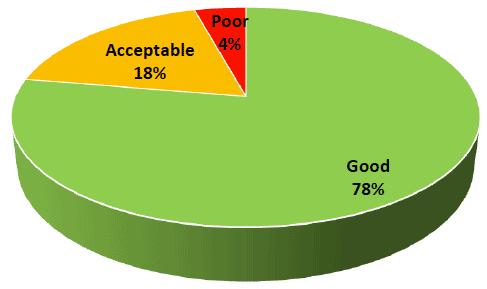
2.4 Medical Equipment Assets
Information has been gathered from each NHS Board and the national imaging and radiotherapy equipment groups to gain a more accurate understanding of the scope and value of medical equipment across NHSScotland. In addition to the global overview of the value of medical equipment, it also sought more detailed information on the following specific equipment types:
- Renal dialysis equipment.
- Cardiac defibrillators.
- Infusion devices.
- Endoscopic equipment.
- Imaging equipment.
- Radiotherapy equipment.
This presented an overall estimated replacement value for Medical Equipment of £940m, which is an increase of £180m from the 2013 reported figure. This is due to a more robust assessment of medical equipment value and the focused inclusion of low value medical equipment (adding £125m, including £32million for devices).
The relative value of each equipment type as described above is shown in the following chart:
Replacement Value of all Medical Equipment (£940m)
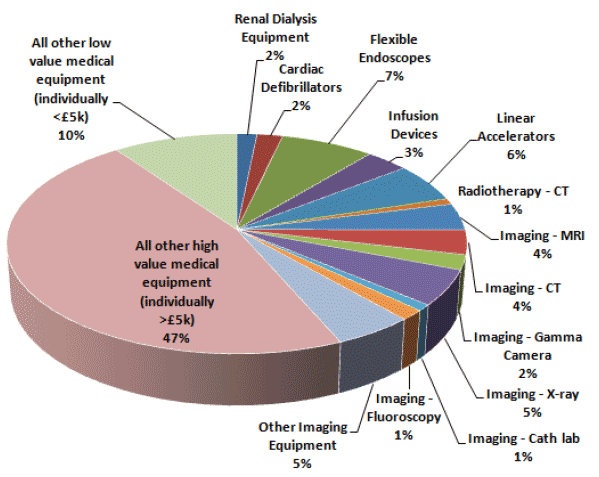
A breakdown per NHS Board of medical equipment replacement value (as reported in the above chart) is provided in the following table:
| NHS Board | Radiotherapy Equipment | Imaging Equipment | All Other Medical Equipment |
|---|---|---|---|
| NHS Greater Glasgow | 26,700,000 | 69,466,500 | 160,329,431 |
| NHS Lothian | 15,300,000 | 25,175,664 | 72,000,800 |
| NHS Tayside | 7,700,000 | 15,905,000 | 86,082,442 |
| NHS Grampian | 7,900,000 | 19,933,944 | 61,883,725 |
| NHS Fife | 9,780,800 | 48,852,587 | |
| NHS Ayrshire & Arran | 10,834,000 | 38,897,140 | |
| NHS Lanarkshire | 12,361,500 | 52,000,000 | |
| NHS Highland | 4,303,000 | 14,561,959 | 37,619,000 |
| NHS Forth Valley | 8,269,500 | 36,835,223 | |
| NHS Dumfries & G. | 5,050,000 | 12,876,373 | |
| NHS Borders | 3,545,000 | 11,019,301 | |
| Golden Jubilee | 7,085,000 | 27,568,480 | |
| NHS Western Isles | 1,335,000 | 3,887,241 | |
| NHS Shetland | 1,290,000 | 3,740,000 | |
| NHS Orkney | 625,000 | 4,019,959 | |
| National Services Scotland | 4,080,000 | 0 | |
| Scottish Ambulance Service | 8,000,000 | ||
| TOTAL | 61,903,000 | 209,298,867 | 665,611,702 |
| 936,813,569 | |||
Medical Equipment replacement within each Health Board is planned either on a rolling annual basis (e.g. endoscopy equipment) or in bursts to ensure standardisation (e.g. replace all defibrillators over a maximum of 2 years to ensure all devices are of the same model to ensure staff competence). Lifetime is based on clinical and technical obsolescence; the latter is often based on lack of service support and availability of parts. It should be recognised that for medical equipment, safety is the first priority, and equipment is maintained to high standards in NHSScotland to ensure low risk of failure or accidents. This high level of maintenance can enable the equipment to be operated safely over extended lifecycles.
Investment in lifecycle replacement of medical equipment can vary considerably on an annual basis and "peaks" of investment are often observed in particular years when major, large equipment is replaced.
A brief summary of the scope, operational value and funding plans associated with these equipment types is described over the following pages:
Renal Dialysis Equipment
Renal dialysis units are lifesaving facilities for people with renal disorders, providing renal replacement therapy. Dialysis machines are critical to these patients' quality of life. Dialysis machines are used within acute hospitals and increasingly in patients' homes, enabling care in the community. Increasingly hospitals are striving to use technology to improve patient's quality of life and this has resulted in the introduction of night-time dialysis sessions within acute hospitals and home dialysis. The survey found approximately 920 dialysis machines across NHSScotland with a replacement value of c.£15m. These support nearly 200,000 patient sessions per year within dedicated Renal Dialysis Units, with circa 65 patients dialysed at home. Approximately £1.4m (10% of value) was spent in 2013/14 on new equipment which would provide full replacement of this equipment type within 10 years (excluding inflationary adjustments). This is considered to be a just adequate investment profile but is tempered by concerns that 29% of units are currently over 8 years old.
Cardiac Defibrillators
A defibrillator is a life-saving machine that gives the heart an electric shock to restore normal heart rhythms in some cases of heart attack. Its importance in saving people from sudden death due to heart attacks is evidence by their prevalence throughout the community in places such as shopping malls. There are 2,160 reported cardiac defibrillators based in hospital environments across NHSScotland, with quantity planning based on the time required to access a defibrillator in case of emergency. Health Boards manage a further 1500 community based defibrillators, which, together with the defibrillators within the Scottish Ambulance Service accounts for an asset with replacement value of c.£20m. Procurements are managed to ensure defibrillator standardisation which is crucial to ensure staff familiarity. Defibrillators are expected to have a lifespan of 10 years which would require an average annual investment of approximately £2m p.a. to replace, though in practice each NHS Board will attempt to replace theirs over a shorter period of time. However, 15% of existing units are currently over 10 years old.
Infusion Devices
An infusion device delivers fluids and medication in solution to the patient in a controlled way. They do so safely, consistently and accurately for a wide range of clinical purposes including general medication delivery typical directly into patient's veins. They provide anaesthesia, chemotherapy, powerful heart acting medication and pain relief, with some devices enabling patients to control their own medication delivery. Their portability enables them to be used in the community, with the widespread use of portable devices, powered by batteries, supporting care in the community, particularly for pain and symptom relief (e.g. nausea and vomiting) in palliative care. Individually the infusions devices cost between about £1k and £3k, but the cumulative value of the almost 20,000 devices is circa £32m.
Endoscopic Equipment
An endoscope is an investigative and screening device used to examine the inside of the body and to diagnose various conditions. Broadly speaking, endoscopy comes in two forms, those for use through natural body openings such as mouth, nose or anus (e.g. colonoscopy screening) or those devices used for surgical procedures such as keyhole surgery. This survey examined the former. These enable minimal invasive procedures often allowing patients to be treated as outpatients. This survey examined the number of flexible endoscopes in use within Scotland, including those used for upper and lower (covering colonoscopy screening) gastrointestinal examinations. There are 2,868 reported flexible endoscopes across NHSScotland with a replacement value of c. £70m. Approximately £3.8m (7% of value) was spent in 2013/14 on new units which would provide full replacement of this equipment type within 15 years (excluding inflationary adjustments). The expected useful lifespan of a flexible endoscope is 10 years, with lifespan dictated by the wear and tear associated with their normal use and their technical (withdrawal of manufacturer support) and clinical obsolescence (improved image quality and ease of use). The flexible endoscopes are used with light sources, video processors and monitors that represent an additional important financial and clinical asset not included in the £70m figure above. Nor is the surgical endoscopy equipment included. NHS Boards will need to carefully review and monitor the whole spectrum of their endoscopic equipment and its future investment requirements. It is also noted that 18% of units are currently over 10 years old.
Imaging Equipment
Imaging equipment plays a significant and important role in the provision of healthcare to patients within both the acute and primary care sectors. Diagnostic procedures increased between 2003/04 and 2006/07 by 38% (according to Audit Scotland), and this trend has continued with an increase of 37% between 2006/07 and 2009/10 in the number of patients having a CT, MRI or ultrasound test. In addition to diagnostic procedures, there is also an increasing number of interventional / therapeutic procedures carried out within imaging directorates. In many cases these have replaced major surgical procedures with minimally invasive procedures that have significantly reduced morbidity and length of hospital stay. The National Imaging Inventory has an estimated replacement value of £210m (incl VAT and turnkey). The annual maintenance charge is £12.4million across the inventory and remains static from previous year.
Radiotherapy Equipment
The 5 Cancer Centres in Scotland have had a co-ordinated national equipment replacement programme in place since 1998, which has been instrumental in ensuring the efficient and timely replacement of radiotherapy equipment across NHSScotland. The continued delivery of cancer access targets is in part due to the timely replacement of ageing equipment. The timing of replacement of equipment reflects current national recommendations and the programme is managed and monitored by the National Radiotherapy Programme Board with the equipment financed from a ring fenced Scottish Government allocation. The success of this programme in introducing leading edge technology to enable the best possible treatment for cancer patients; with equity of access across Scotland, is considered to be a best practice model for the management and procurement of medical equipment.
2.5 IM&T Assets
Information on IM&T assets is based on data collected from the eHealth IM&T survey carried out in 2012. The purpose of that survey was to provide a baseline of overall IM&T expenditure within NHSScotland in order that a better understanding could be gained on the current profile of investment in IM&T, identify priority areas for future development and shape future investment plans. The survey also collected information on client devices and peripherals (devices are items such as desktop computers, laptops, tablets etc; whereas peripherals are items that support these devices, such as printers).
The following two charts provide a breakdown of information gathered on client devices and peripherals related to the number of such devices.
Total Client Devices, 132,306
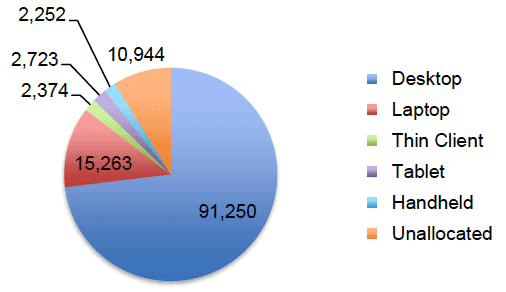
Total Peripherals, 51,133
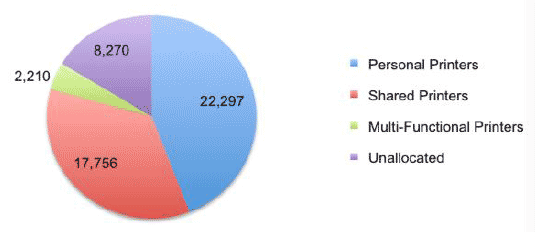
This information can be regarded as a baseline year which NHS Scotland can use to monitor future trends in the use of devices and peripherals. For example, NHS Scotland anticipates that the use of tablets and handheld devices will increase in future as the volume of care provided in the home environment increases and staff work on a more mobile / home working basis. By capturing this basic data, NHS Scotland will be able to monitor trends in device usage and use this information to inform future service planning.
Contact
Email: Gillian McCallum
There is a problem
Thanks for your feedback